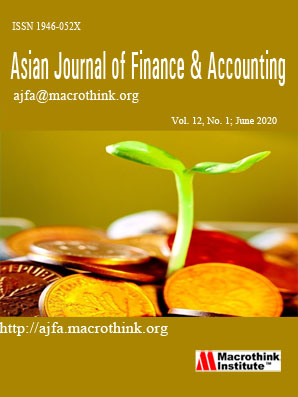The Ability of Traditional and Modern Performance Indicators in Interpreting the Phenomenon of Earnings Management: Evidence Manufacturing Firms in Amman Stock Exchange
Abstract
The study objects for investigating the ability of traditional and modern performance indicators in interpreting earnings management phenomena of listed manufacturing firms in the Amman Stock Exchange (ASE), using adjusted Jones method for measuring earnings management. The study takes into considerations three traditional indicators, including; Return on Assets (ROA), Return on Sales (ROS), and Operating Cash Flow, while the Market Value Added (MVA), Tobin's-Q, and Economic Value Added (EVA) are used as modern indicators for financial performance. A sample consisted of 29 firms had been selected, and data covering the period 2006-2013 had been collected from these firms, where 232 observations were used in the analysis. The study found that the earnings management of listed manufacturing firms at (ASE) still practice the phenomenon of earnings management, at low level based on the measures followed by the study, and that there is a significant linear relationship between performance indicators (traditional and modern) and earnings management. The results indicate that there is a significant as well inverse relationship between (ROA) and earnings management. Also, the study found that modern performance indicators are able to interpret earnings management, where the results indicate that there is a significant as well as inverse relationship between (EVA), and (Tobin's-q) and earnings management. One important finding showed that (EVE) is effective and followed by (Tobin's-q) indicator in interpreting the earnings management phenomena. However, the study did not show a significant relationship between CFO, LEV Ratio, ROS, and MVA with earnings management. Based on these results, the study made many recommendations to the interested parties and the most important one is that companies must disclose the economic value added in the financial statements to enable investors and related parties to be aware of the amount of value-added that lead to increase the wealth of shareholders, and to help managers to consider all costs of capital. In addition, these indicators can be used with other indicators such as (ROA, ROE) to evaluate firm’s performance.
Submission of an article implies that the work described has not been published previously (except in the form of an abstract or as part of a published lecture or academic thesis), that it is not under consideration for publication elsewhere, that its publication is approved by all authors and tacitly or explicitly by the responsible authorities where the work was carried out, and that, if accepted, will not be published elsewhere in the same form, in English or in any other language, without the written consent of the Publisher. The Editors reserve the right to edit or otherwise alter all contributions, but authors will receive proofs for approval before publication.
Copyrights for articles published in MTI journals are retained by the authors, with first publication rights granted to the journal. The journal/publisher is not responsible for subsequent uses of the work. It is the author's responsibility to bring an infringement action if so desired by the author.








